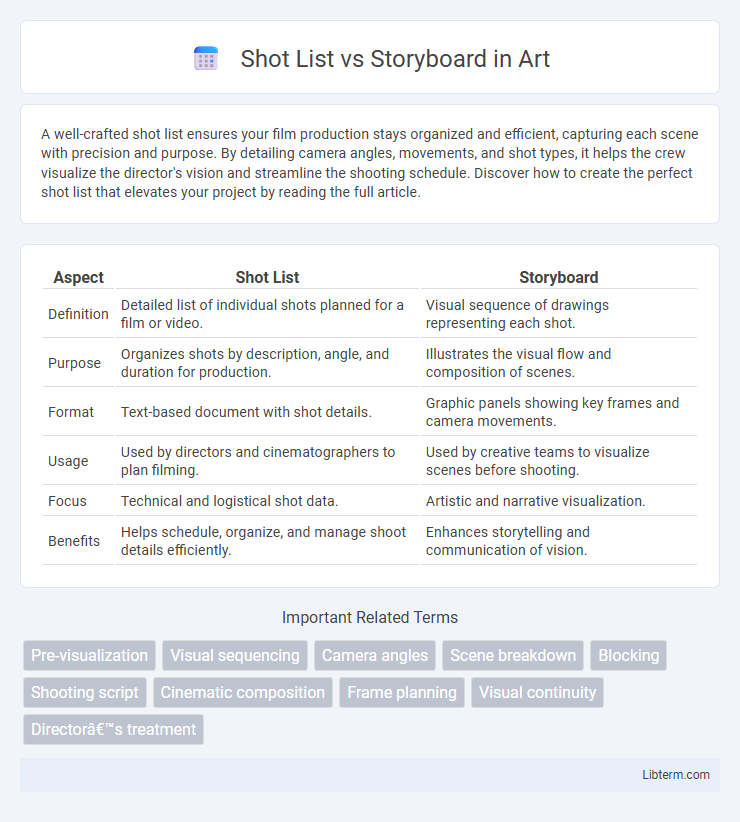A well-crafted shot list ensures your film production stays organized and efficient, capturing each scene with precision and purpose. By detailing camera angles, movements, and shot types, it helps the crew visualize the director's vision and streamline the shooting schedule. Discover how to create the perfect shot list that elevates your project by reading the full article.
Table of Comparison
| Aspect | Shot List | Storyboard |
|---|---|---|
| Definition | Detailed list of individual shots planned for a film or video. | Visual sequence of drawings representing each shot. |
| Purpose | Organizes shots by description, angle, and duration for production. | Illustrates the visual flow and composition of scenes. |
| Format | Text-based document with shot details. | Graphic panels showing key frames and camera movements. |
| Usage | Used by directors and cinematographers to plan filming. | Used by creative teams to visualize scenes before shooting. |
| Focus | Technical and logistical shot data. | Artistic and narrative visualization. |
| Benefits | Helps schedule, organize, and manage shoot details efficiently. | Enhances storytelling and communication of vision. |
Introduction to Shot Lists and Storyboards
Shot lists organize each scene's specific shots, detailing camera angles, movement, and timing to guide the filming process efficiently. Storyboards visually map out sequences as illustrations or images, providing a clear representation of composition and narrative flow before production begins. Both tools enhance pre-production planning by aligning the director's vision with the crew's execution.
Defining a Shot List
A shot list is a detailed inventory of all the shots planned for a film or video production, specifying camera angles, framing, and actions for each scene. It serves as a practical guide for directors, cinematographers, and crew to efficiently organize shooting schedules and ensure coverage of essential footage. Unlike storyboards, which visually depict scenes through illustrations, a shot list focuses on the technical and logistical aspects of capturing each shot.
What is a Storyboard?
A storyboard is a visual representation of a film or video sequence, consisting of a series of illustrated frames that outline key scenes and camera angles. It serves as a blueprint for production, helping directors, cinematographers, and crew visualize the narrative flow and plan the shot composition. Unlike a shot list that is text-based and lists individual shots, a storyboard provides a detailed, scene-by-scene graphical layout to guide the filming process.
Key Differences Between Shot Lists and Storyboards
Shot lists serve as detailed inventories of every camera shot, specifying angles, movements, and timings, facilitating precise logistical planning. Storyboards, in contrast, offer visual representations of scenes through sequential drawings, aiding in conceptualizing composition, pacing, and narrative flow. While shot lists emphasize technical details for production efficiency, storyboards focus on visual storytelling and creative direction.
The Role of Shot Lists in Filmmaking
Shot lists play a crucial role in filmmaking by providing a detailed blueprint of every camera shot needed for a production, enabling efficient shooting schedules and clear communication among the crew. They help directors, cinematographers, and editors visualize the sequence and composition of scenes, ensuring that all necessary footage is captured to accurately tell the story. Unlike storyboards, which offer visual sketches of scenes, shot lists focus on logistical details such as shot type, camera movement, and timing, streamlining the production process.
How Storyboards Guide Visual Narratives
Storyboards guide visual narratives by providing a detailed, frame-by-frame representation of scenes, allowing directors and cinematographers to visualize camera angles, movements, and transitions before filming. This pre-visualization tool ensures coherent storytelling by aligning the creative team's vision and facilitating efficient production planning. Unlike shot lists, which simply list scenes and shots, storyboards offer a richer, illustrated roadmap that enhances narrative flow and emotional impact.
When to Use a Shot List vs a Storyboard
A shot list is ideal during pre-production for organizing and sequencing camera angles, lens choices, and shot types, ensuring efficient scheduling and on-set communication. Storyboards are best used when visualizing complex scenes or choreography, allowing directors, cinematographers, and production teams to anticipate spatial relationships and action flow. Choose a shot list for straightforward projects needing quick reference, and a storyboard when detailed visual planning is crucial for narrative clarity and creative collaboration.
Advantages of Combining Both Tools
Combining a shot list and storyboard enhances visual storytelling by providing a comprehensive blueprint that ensures precise shot execution and clear scene visualization. This integration streamlines communication across the production team, reducing misunderstandings and increasing efficiency during filming. Filmmakers benefit from a stronger alignment between creative vision and technical planning, resulting in a more cohesive and polished final product.
Common Mistakes to Avoid
Confusing a shot list with a storyboard often leads to overlooked visual planning, as shot lists detail camera angles and sequences while storyboards provide illustrated frames for scene visualization. Avoid assuming shot lists alone convey narrative flow, which can result in disjointed scenes and unclear director-cinematographer communication. Neglecting to update either document during production risks continuity errors and inefficient shooting schedules.
Conclusion: Choosing the Right Tool for Your Project
Selecting between a shot list and a storyboard depends on the specific needs of your production, with shot lists offering streamlined planning for straightforward projects and storyboards providing detailed visual guidance for complex narratives. Incorporating both tools can enhance communication among team members, improve shot organization, and ensure a cohesive final product. Prioritizing clarity, efficiency, and project scope will guide filmmakers in choosing the optimal pre-production method.
Shot List Infographic

 libterm.com
libterm.com